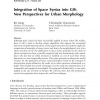Free Online Productivity Tools
i2Speak
i2Symbol
i2OCR
iTex2Img
iWeb2Print
iWeb2Shot
i2Type
iPdf2Split
iPdf2Merge
i2Bopomofo
i2Arabic
i2Style
i2Image
i2PDF
iLatex2Rtf
Sci2ools
TGIS
2002
2002
Integration of Space Syntax into GIS: New Perspectives for Urban Morphology
Although space syntax has been successfully applied to many urban GIS studies, there is still a need to develop robust algorithms that support the automated derivation of graph representations. These graph structures are needed to apply the computational principles of space syntax and derive the morphological view of an urban structure. So far the application of space syntax principles to the study of urban structures has been a partially empirical and non-deterministic task, mainly due to the fact that an urban structure is modeled as a set of axial lines whose derivation is a non-computable process. This paper proposes an alternative model of space for the application of space syntax principles, based on the concepts of characteristic points defined as the nodes of an urban structure schematised as a graph. This method has several advantages over the axial line representation: it is computable and cognitively meaningful. Our proposal is illustrated by a case study applied to the cit...
| Added | 23 Dec 2010 |
| Updated | 23 Dec 2010 |
| Type | Journal |
| Year | 2002 |
| Where | TGIS |
| Authors | Bin Jiang, Christophe Claramunt |
Comments (0)

